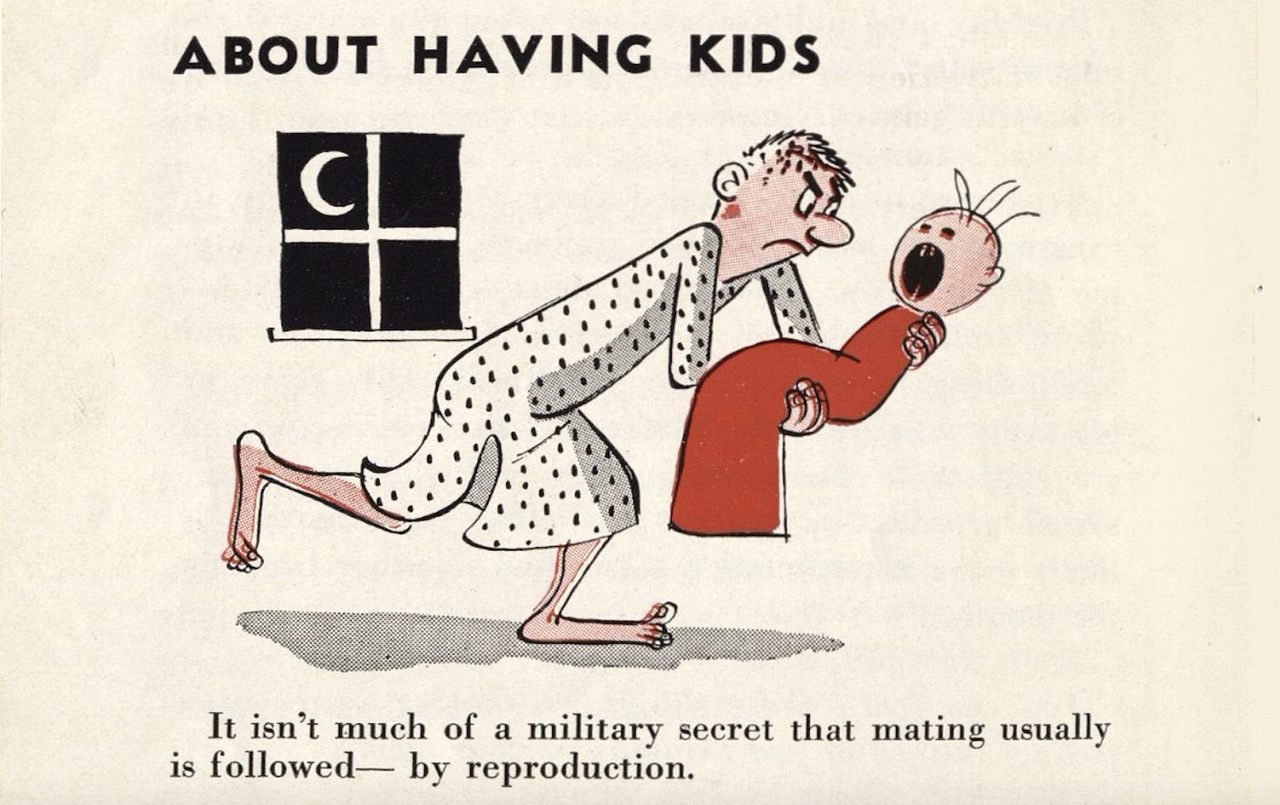
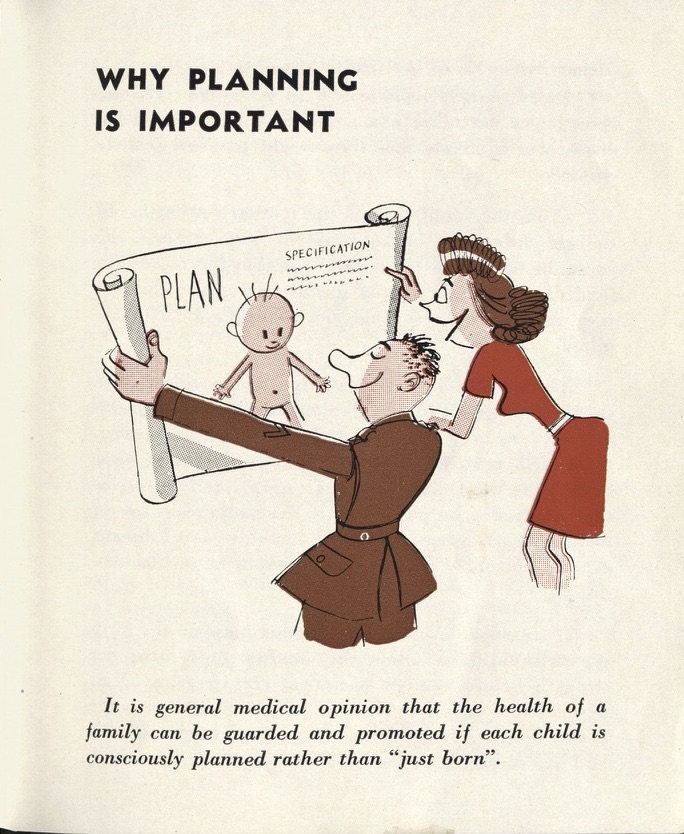

When asked to state the ideal size for a family, ¾ of women answered "3, 4, or more" children. In 1941, the majority said 2 children.
1946-64: 76.4 M babies born, c. 40% of 1964 pop. of 192 M.
1930s: 15% of married women are childless; 1960: 8% are.
Some numbers:
Baby boom: the birthrate is 18.7 in 1935 (and maintains a consistent range of 18.4-19.4 per 1000 population, 1932-40), but it peaks at 26.6 in 1947 and remains 24.0 or higher until 1959, still 21 in 1964. 


When asked to state the ideal size for a family, ¾ of women answered "3, 4, or more" children. In 1941, the majority said 2 children.
1946-64: 76.4 M babies born, c. 40% of 1964 pop. of 192 M.
1930s: 15% of married women are childless; 1960: 8% are.
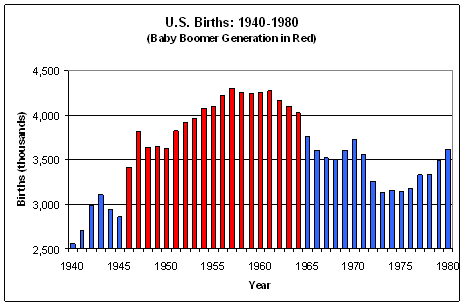
Marriage rates (per 1000 unmarried women):
1939: 73
1940: 82.8
1946: 118.1
1947-1951, range between 86.6 and 102.1
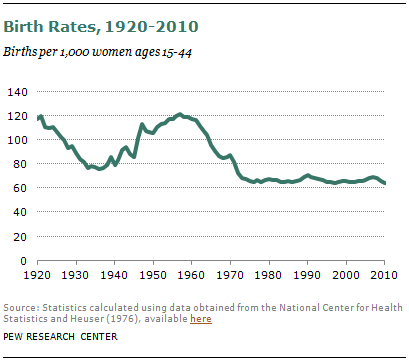
By 1958, 14 M women are engaged by age 17. American marriage rate (90% of Americans are married at some point in their lives) is the planet’s highest.
Year % of women married by age 24
1940 42
1960 70
1995 50
Curious about things now?
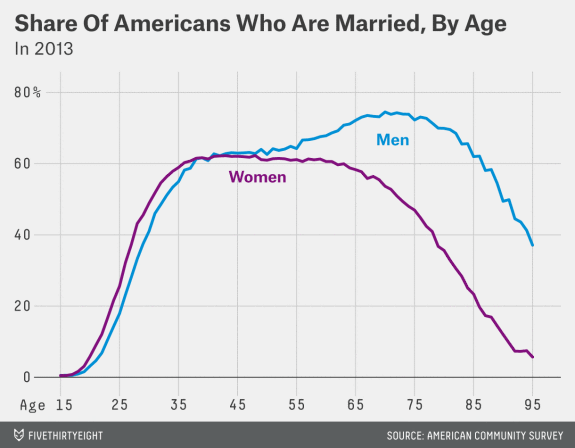
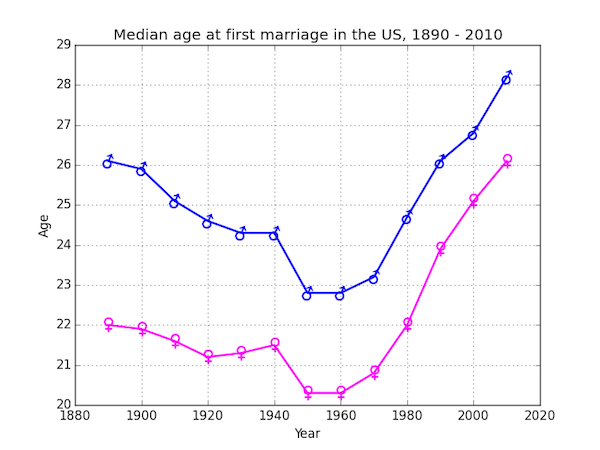
1865-1995: American divorce rate increases approx. 3%/decade.
Except: 1947-1960, it levels off, and actually drops to 1940 level by 1958.
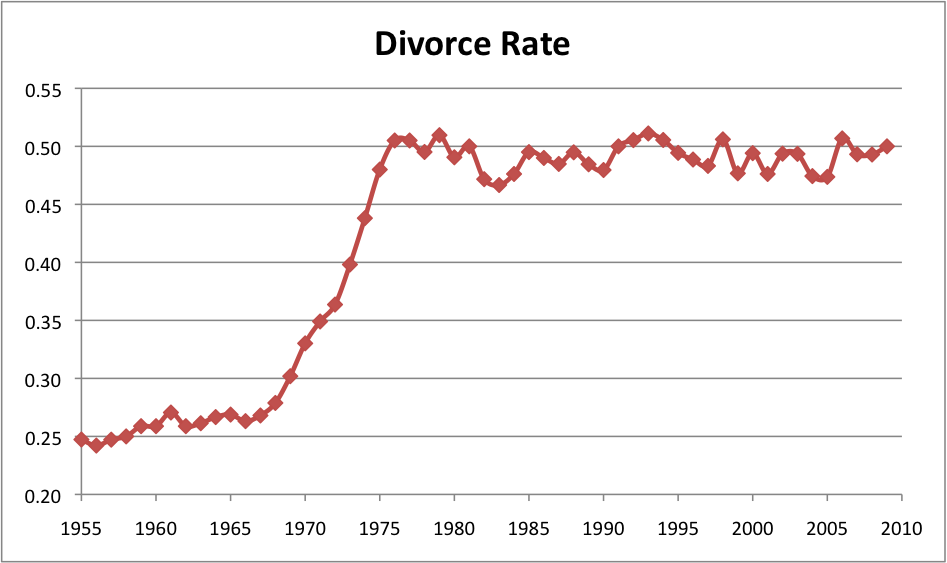
A 1945 survey discovers that the average farm wife spends 60 hours/week on housework; the average city wife, 80 hours/week.
1940: 36% of female labor force is married women; 1950: 52%; 1960: 60%; 1970: 63%.
What do women want? what don't women want? (Mostly, but not always, according to men.)
House Un-American Committee pamphlet, quoting Columbia professor John Hanna: “The girls’ schools and women’s colleges contain some of the most loyal disciples of Russia. Teachers there are often frustrated females. They have gone through personal struggles to attain their positions. A political dogma based on hatred expresses their personal attitudes.”
Psychologists Marynia Farndham and Ferdinand Lundberg, 1947: “The woman needs to have in her unconscious mind the knowledge that for her the sex act, to yield maximum satisfaction, terminates only with childbirth or the end of the nursing period.”
The big problem is what is revealed in the work of Alfred Kinsey, Sexual Behavior in the Human Male, 1948: c. 90% of men have had premarital sex, 3/8 have had homosexual experience. 50% have had affairs. Sexual Behavior in the Human Female, 1953: 50% of women have had premarital sex; 1/8 have had homosexual experience; 26% have had affairs. The entire culture of this period is built on a notion, as we've just read, that men are sexual and women aren't, which is almost Victorian in its prudery. (Note how many of the "experts" quoted here assert that women should basically just lie there. Eventually, acceptance of these truths created the "sex comedies" your next reading discusses. This is also made easier by widespread availability of The Pill, which begins in 1960, and legalization of contraception in Griswold v Connecticut, 1965.)
Kinsey was controversial because he was an entomologist (he had previously studied wasps) and thus made no judgments of what he found (he treated people like wasps and just studied what they did), which many people found highly off-putting. You can see that this kind of work remained controversial if you watch the TV show Masters of Sex, which looks at Virginia Masters and William Johnson, whose work together began in 1957 and continued through the 1970s.
Harry Truman: women’s rights were “a lot of hooey.”
“How to be a Woman,” Seventeen, 1950: the young woman “is a partner of man, not his rival, enemy, or plaything. Your partnership in most cases will produce children, and together you and the man will create a haven, a home, a way of life for yourselves and your children.” Being a mother is an “exciting career.” Pepsi teaches you how to live a fulfilling life, 1957. ("Today's Pepsi-Cola" helps her out in remaining slim and attractive.)
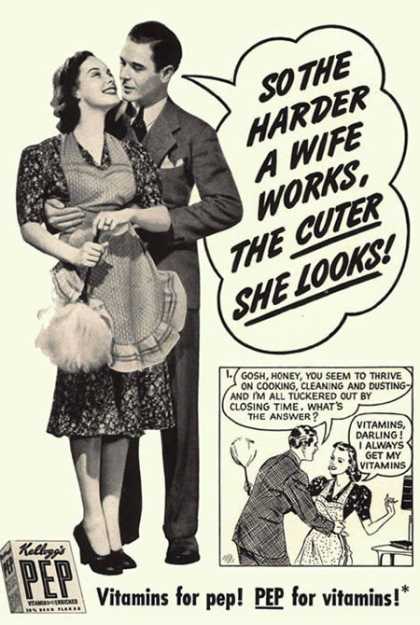
Agnes Meyer, “Women Aren’t Men,” Atlantic Monthly, 1950: “Women have many careers but only one vocation—motherhood. It is for woman as mother, actual or vicarious, to restore security in our insecure world.” The woman in this Crest ad has not gotten the message.
This leads to the classic notion of "domestic containment," the idea that terrifying external Cold-War traumas can be contained within the household by re-establishing a strong nuclear family with defined roles for the parents.
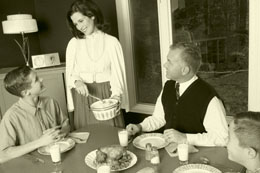
The new ideal of marriage is “companionate,” allegedly an equal partnership. (“Togetherness” is a term coined by McCall’s, 1954.) One expert notes that the wife’s job is to “understand her husband, to help him understand himself, and to help him rise to his capacities.” Seventeen, 1957: “In dealing with a male, the art of saving face is essential. Traditionally he is head of the family, the dominant partner, the man in the situation. Even on those occasions when you both know his decision is wrong, more often than not you will be wise to go along with his decision.”
Look, special issue on American women, 1956: “this wondrous creature marries younger than ever, bears more babies and looks and acts far more feminine than the emancipated girl of the 1920s or even 30s. [She has found] a new center, neither Victorian nor rampantly feminist. Today, if she makes an old-fashioned choice and lovingly tends a garden and a bumper crop of children, she rates louder hosannas than ever before….If, by contrast, she chooses to take six to ten years out for family, then return to the work for which she was educated, no one fusses much about that either.”
so, should women go to college?
Gimbel’s ad, 1952: “What’s college? That’s where girls who are above cooking and sewing can go to meet a man so they can spend their lives cooking and sewing.”
Larger % of women than men graduate high school. But in 1950: 721,000 women in college, 1.56 M men. 1960: 1.3 M women, 2.26 M men. 37% of women graduate college, 55% of men; 60% of women who left college did so either to marry or b/c they feared a college education would hurt their marrigeability. 1950: 643 female PhDs, 5990 male granted; 1960: 1028 women, 8800 men.

Women are 6% of American doctors, 3% of lawyers, <1% of engineers, 1.4 % of top 4 pay grades in US government. Women occupy less than 5% of public offices, nationwide.
Adlai Stevenson to Smith College graduates, 1955: women “feel frustrated and far apart from the great issues and stirring debate for which their education has given them understanding and relish. Once they wrote poetry. Now it’s the laundry list.” Nonetheless, the woman can “inspire in her home a vision of the meaning of life and freedom…help her husband find values that will give purpose to his specialized daily chores…and teach her children the uniqueness of each individual human being.”
Margaret Pickel, dean of Barnard: women cannot compete with men in the workplace because they have “less physical strength, a lower fatigue point, and a less stable nervous system.” At a pre-graduation party at Barnard in 1960, seniors with fiancees are handed corsages; those without are handed lemons.
1961: the Supreme Court rules unanimously that a Florida law making jury duty mandatory only for men does not deny women justice in court, noting in classic separate-spheres fashion that the "practice of excluding women from the jury pool" protects them "from the filth, obscenity, and obnoxious atmosphere...of the courtroom." Justice John Marshall Harlan II: "woman is still regarded as the center of home and family life."
Redbook runs a contest for best essay on the topic of “Why Young Mothers Feel Trapped,” 1960; gets 24,000 replies. Betty Friedan, 1960: “There is a strange stirring, a dissatisfied groping, a yearning, a search that is going on in the minds of women.”
1962: In a Gallup poll, nearly 2/3 of women 18-60 don't approve of the idea of a female President. In U. Michigan poll, more than two-thirds of the women surveyed agree that most important family decisions “should be made by the man of the house.”
Dominant domestic ideology heavily emphasized child-rearing and housekeeping as fulfilling activities for women, most famously attacked in Friedan’s The Feminine Mystique in 1963 as “the problem with no name.” For Friedan, the middle-class house was a “comfortable concentration camp”: what do you do at 10am, after the kids have been packed off to school and the house is clean?
We see this dramatized particularly often in images of things like vacuuming, which women are told can be a source of immense satisfaction if done correctly.
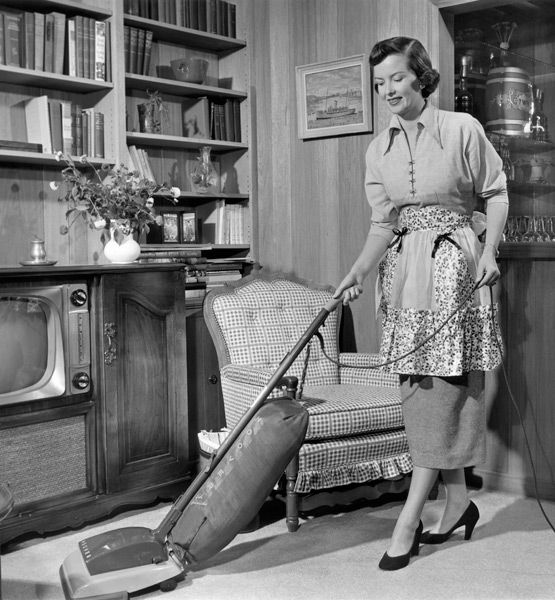
June Cleaver, the mom on Leave It to Beaver (on the air 1957-1963), was particularly notable for wearing pearls on all occasions, especially when doing household tasks. Here she gives the Beav some useful advice while peeling something or other.
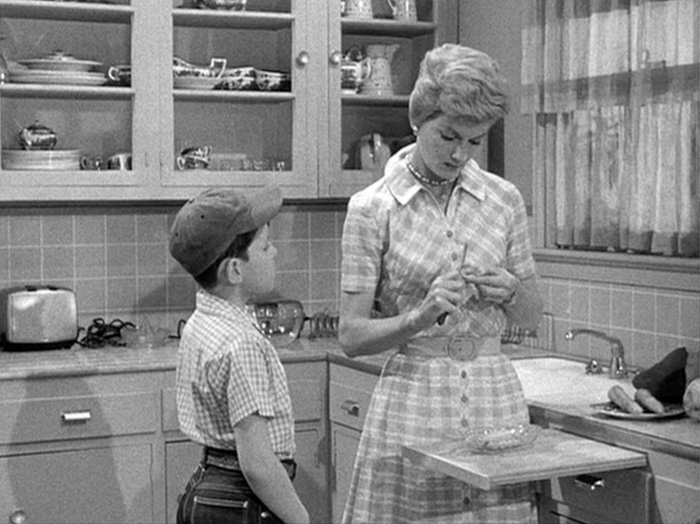
But she pretty much just wore pearls whatever she was doing around the house,
|
whether it was cooking,
|
entertaining,
|
giving advice,
|
or whatever--she barely left the house, but she always had her pearls working.
sex and the single girl
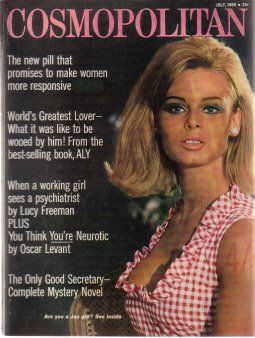
Helen Gurley Brown (founder of Cosmopolitan), Sex and the Single Girl, 1962: “When I got married, I moved in with six pound dumbbells, a slant board, an electronic device for erasing wrinkles, and enough high-powered vitamins to generate life in a statue.” The single girl “is engaging because she lives by her wits. She supports herself. She is not a parasite, a dependent, a scrounger, a sponger, a bum. She is a giver, not a taker, a winner, not a loser.”
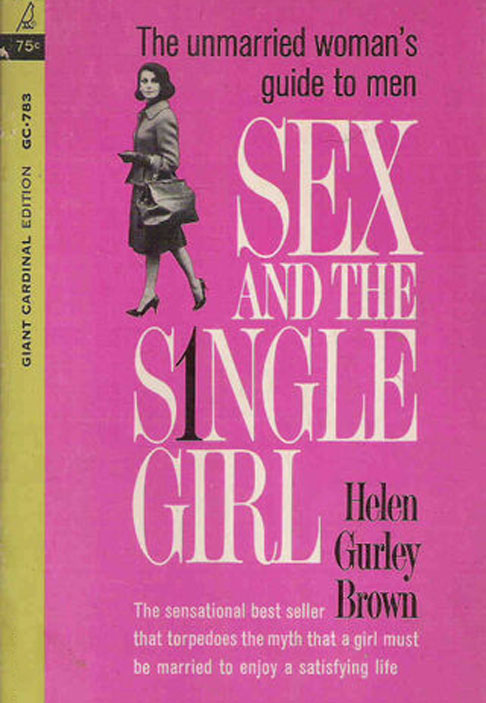
Alexander King of Life, responding to Brown: “The assumption that a woman is supposed to get something out of her sexual contact, something joyful and satisfactory, is a very recent idea. But this idea has been carried too far, too. It’s become so that women are sitting like district attorneys, to see what the man can or cannot perform and this has put men tremendously on the defensive. This absolute, unquestioned equality is a great mistake and in violation of all natural laws. It is a mistake because democracy is all right politically, but it’s no good in the home.” The fact that women were becoming so “dominant,” he said, was an important factor in the rise of “pansies.”
Theodor Reik, psychologist: “There is a law—as binding as the laws of chemistry or of physics—that a masculinization of women goes with the womanization of men.”
# professional women rises 41%, 1940-1960. Survey of female executives, 1956, shows that all value home and family above their jobs but believe they can satisfy the demands of each “if they want to badly enough.”
1945: 35.8% of working-age women are in labor force. (14 million)
1950: 33.9% (18.5 million)
1960: 37.8% (23.3 million)
Median income of full-time female workers 63% of male median, 1945; 57%, 1973.
Changing percentages of women earning various degrees:
| year |
BAs
|
PhDs
|
MDs
|
| 1960 | 38.5% | 10.5% | 5.5% |
| 1970 | 43.1 | 13.3 | 8.4 |
| 1980 | 49 | 29.7 | 23.4 |
| 1996 | 55.1 | 45.4 | 40.9 |
|
Law
|
MBAs
|
Engineering
|
|
| 1960 | 2.5% | 3.6% | 0.4% |
| 1970 | 5.4 | 3.6 | 0.8 |
| 1980 | 30.2 | 22.4 | 9.3 |
| 1996 | 43.5 | 37.6 | 16.1 |